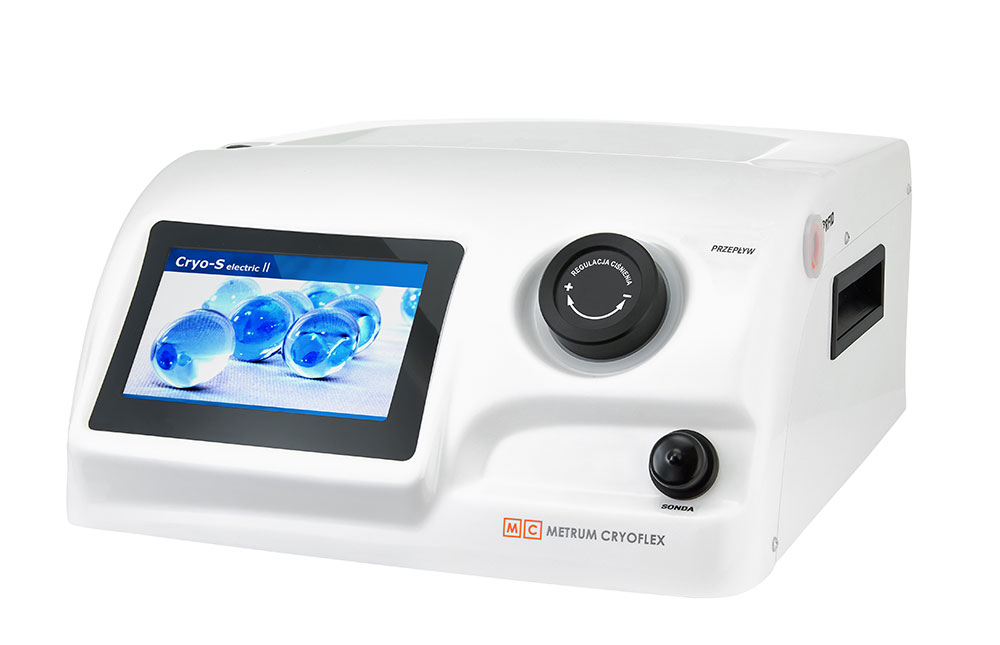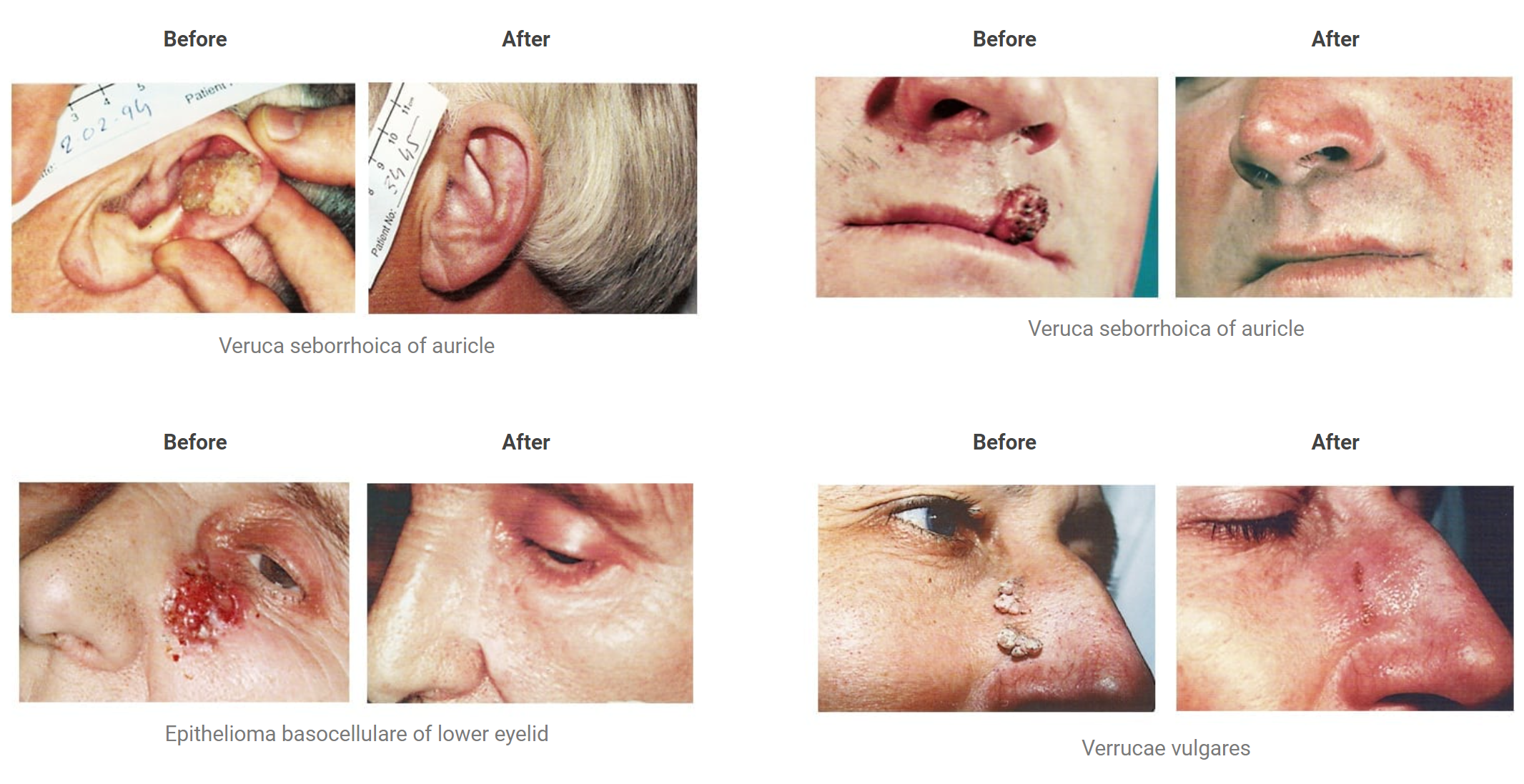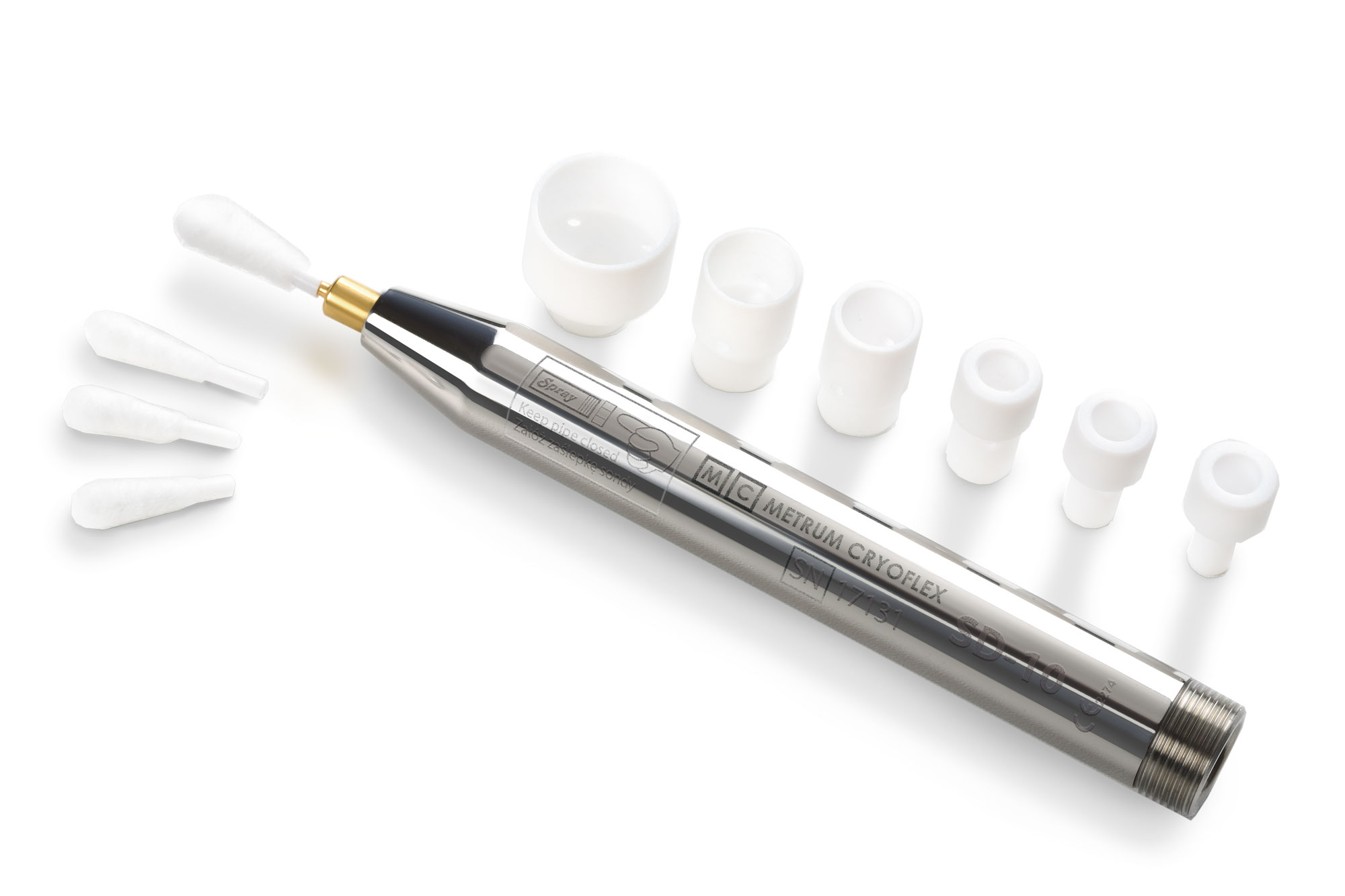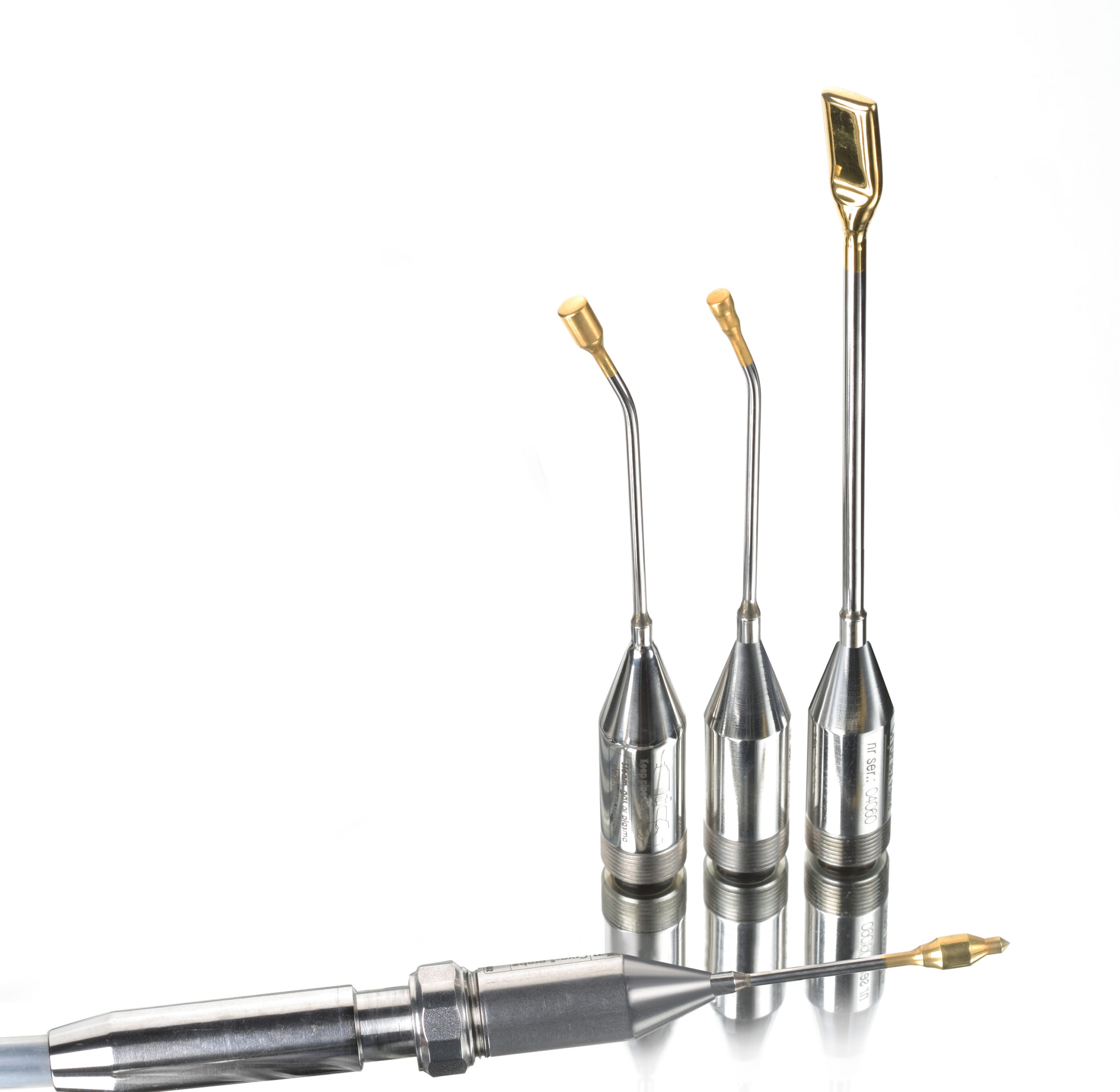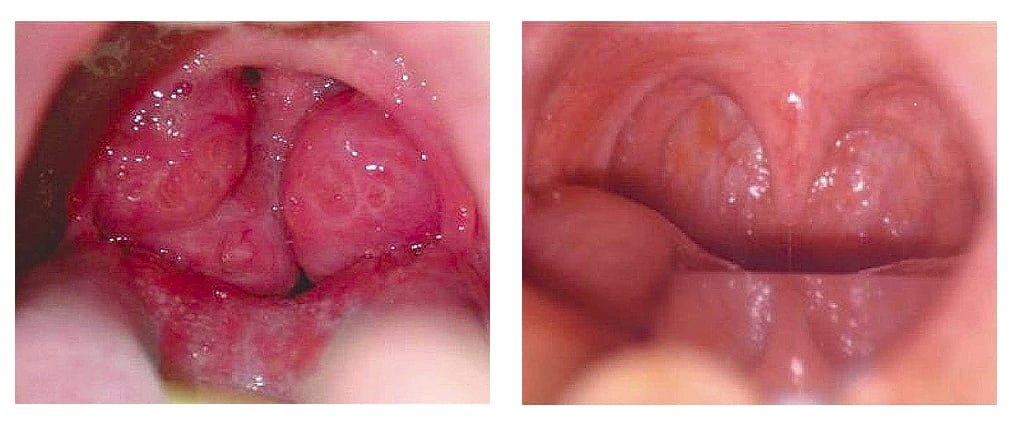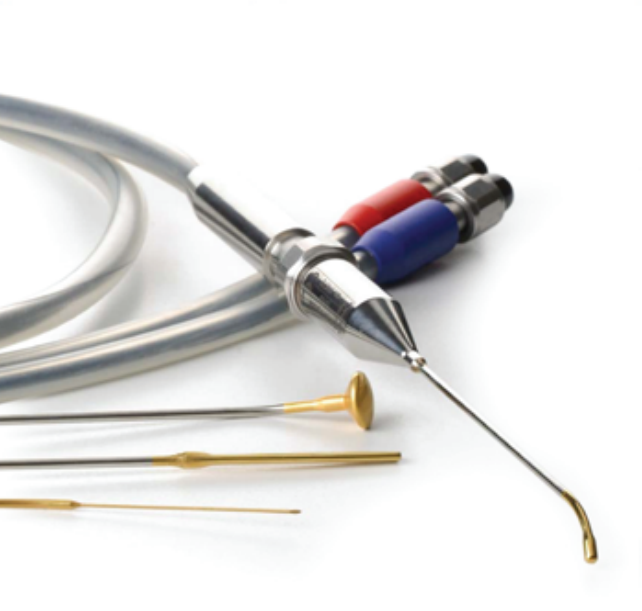CRYO-S Electric II
CRYO-S ® Electric II is state-of-the-art cryosurgical device manufactured by METRUM CRYOFLEX is the next generation of apparatus used in the surgery field since 1992.
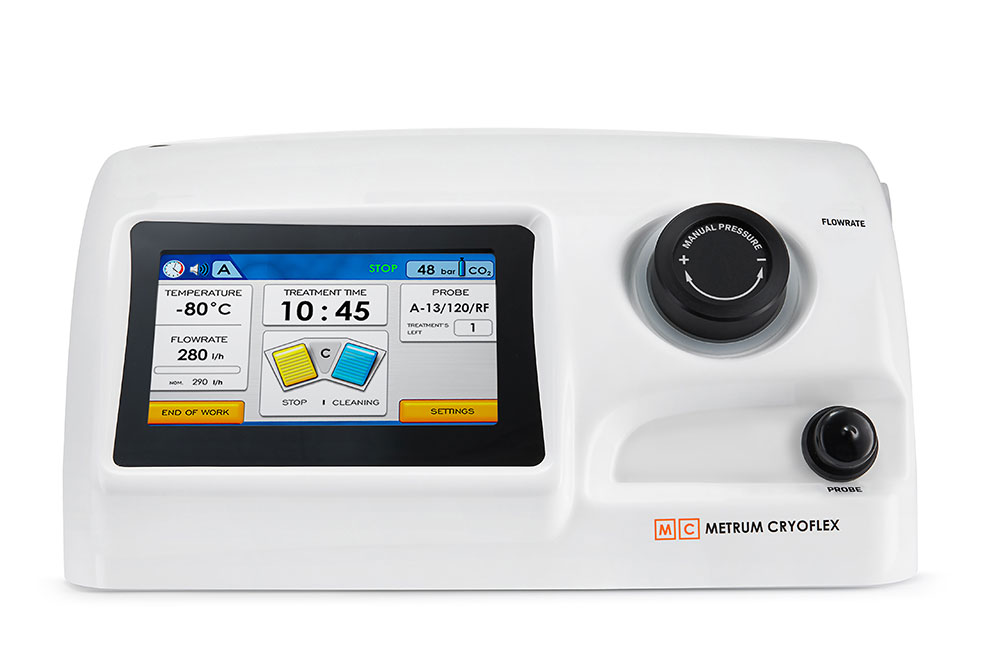

Mode selection probe, cleaning and freezing can be performed automatically using footswitch or convenient touch screen which allows to keep the site of a procedure under sterile conditions.

RFiD – electronic communication between the probe and device allows recognition of optimal operating parameters and auto-configures to cryoprobe characteristic. Pressure and gas flow are set automatically, any manual adjustment is not necessary.

Contains automatic cryoprobe test system and two freezing modes (continous and sequential). Probe test system includes autocleaning and short freezing test.

Built-in voice communication for easier work. System informing about key figures during procedure.

Pressure and gas flow are set automatically, any manual adjustment is not necessary. Automatic working modes (stop, preparation, ready, freezing, cleaning).

The working medium for CRYO-S ® Electric II is carbon dioxide: CO2 (-78°C) or nitrous oxide: N2O (-89°C), very efficient and easy to use gases.
A 10 liter cylinder of CO2/N2O serves for approximately 60 procedures.
User friendly interface
CRYO-S ® Electric II is controlled by a microprocessor and all the parameters are displayed and monitored on a LCD screen. Cryoprobe temperature, cylinder pressure, gas flow inside of cryobrobe and procedure time are displayed during freezing.
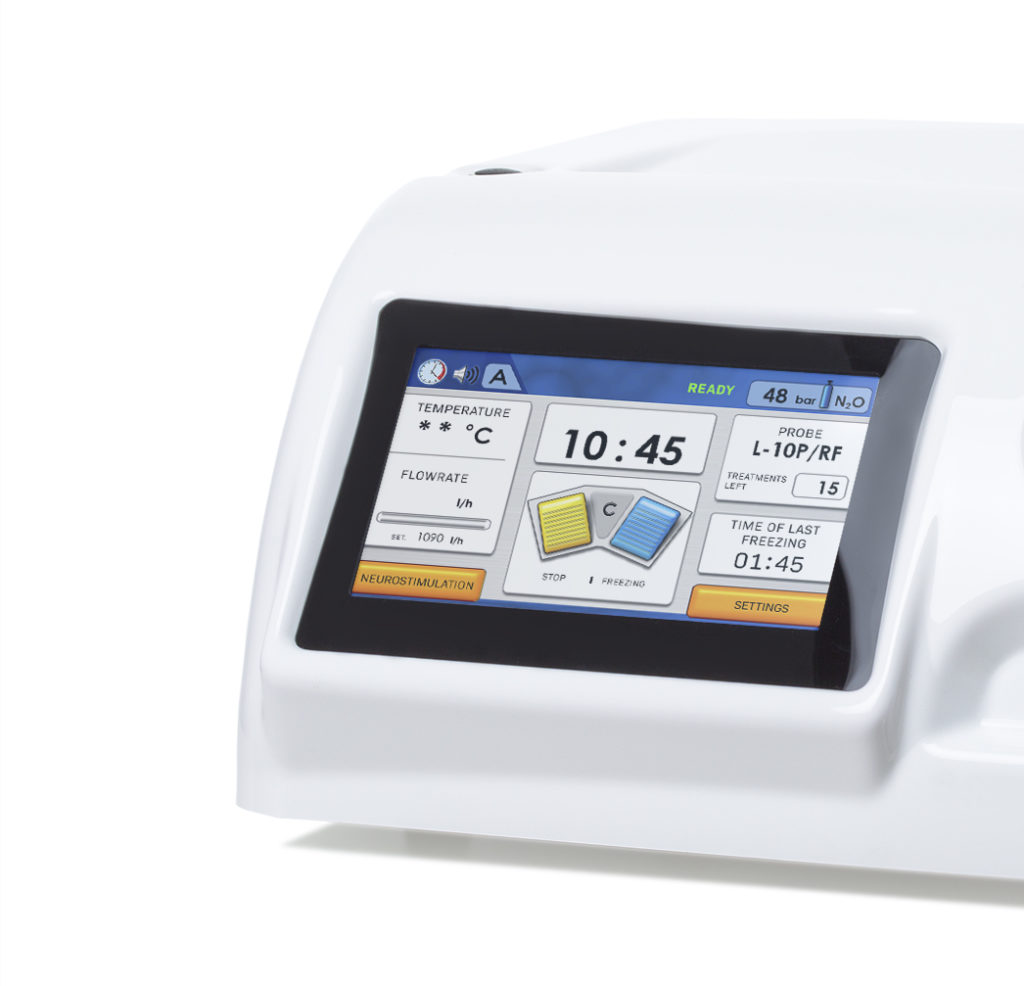
30 years of experience
CRYO-S ® Electric II state-of-the-art cryosurgical device manufactured by METRUM CRYOFLEX is the next generation of apparatus used by many experts in the field since 1992.
Cryoprobes which meet the highest standarts of quality
Wide range of contact cryoprobes – single and multiple use as well. Needle shaped cryoprobe is only 0,8 mm in diameter – excellent for treatment of intramucosal conchoplasty. Special construction enables precise freezing and fast defrosting.
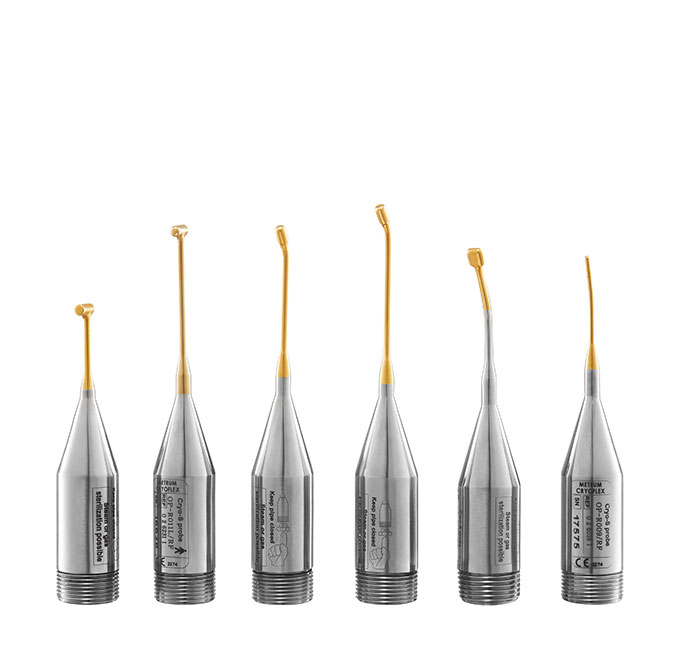

High quality of cryoprobes which are cover with 24 carat gold.

Sterilization cryoprobe possible in autoclaves 134°C, 3 minutes

The wide range of cryoprobes for vitreous, retinaland and palpebrals.
Technical specification
- Power requirements
- Power 100÷240 V (50/60 Hz) AC
- Maximum power consumption 150 VA
- Cooling medium
- CO2 -78°C or N2O -89°C
- Maximum pressure 70 bars (CO2) and 55 bars (N2O)
- Working pressure 48÷65 bars (CO2), 38-53 bars (N2O)
- LCD screen (touch)
- Voice information system (information about key figures during procedure)
- Comfortable foot switch controler (dual function).
- Automatic/Manual control of the flow rate parameters
- Automatic gas pressure control
- Freezing temperature indicator
- automatic working modes (stop, preparation, ready, freezing, cleaning)
- Cryoprobe information system (information about type of probe used, number of treatments left for the specific probe)
Functional modes of unique cryoprobe prepairing system:
- Standard – Cryoprobe is cleaned before each procedure for several seconds and than few seconds of testing freezing is performed. In this mode cryoprobe is tested and prepared according to parameters programmed on attached microchip. When such preparation is finished cryoprobe is ready for freezing.
- Service – it starts automatically when decreased flow rate in cryoprobe or cryoprobe blockage is noticed. It can be performed also during the procedure. Service mode is diagnosing and solving problems caused by previous improper use of the cryoprobe, improperly performed sterilization or low quality of gas.
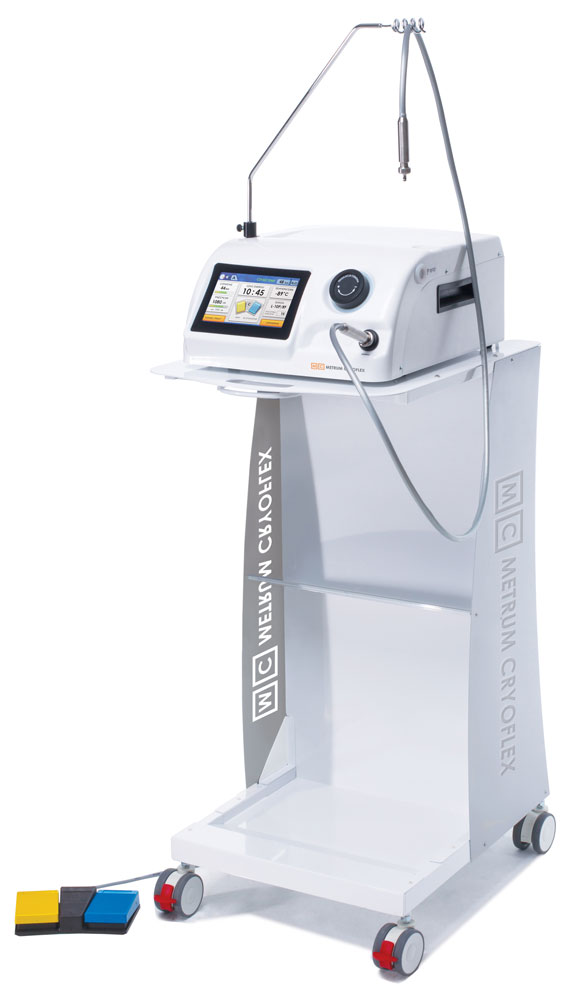
Specializations
Cryotherapy have been used to freeze living tissue for the purpose of treating benign and malignant lesions. Within the last century, ophthalmologists have found cryotherapy to be useful in treating a variety of ocular pathologies. Cryosurgery has been used to treat a variety of ophthalmic conditions, including surface and intraocular pathology. Cryosurgery may be preferable in treating certain surface and intraoculus diseases (including benign and malignant lesions), as there are few post-operative adverse events and limited long-term complications when compared to radiation and chemotherapy.
Application in ophthalmology
- Retinal cryopexy continues to be used as a means of repairing retinal breaks (holes or tears), which have long been recognized to be the cause of most retinal detachments. Application of cold to the choroid and retinal pigment epithelium yields cell death and subsequent scarring, resulting in sealing of the edges of retinal breaks.
- Cyclocryopexy for advanced glaucoma – In severe intractable glaucoma that is not amenable to conventional glaucoma medication or surgery, ocular cryopexy applied to the ciliary body through a transscleral application can reduce aqueous production, thereby lowering intraocular pressure Peripheral retinal cryoablation for neovascular glaucoma – Destruction of the peripheral retina by means of cryotherapy can cause iris neovascularization to recede in neovascular glaucoma.
- Retinal cryoablation for retinopathy of prematurity (ROP) – In multicenter prospective clinical trials, destruction of the peripheral retina in premature infants with ROP slows disease progression and improves the chance of maintenance of vision; ocular cryotherapy has markedly altered the prognosis of ROP.
- Retinal cryoablation for peripheral uveitis (intermediate uveitis or pars planitis) – Destruction of the far peripheral retina can reduce peripheral uveitis and cause improvement in macular edema secondary to peripheral uveitis.
- Transconjunctival cryotherapy for retinal toxoplasmosis – Active toxoplasmic lesions in the peripheral retina can be treated with transconjunctival cryotherapy; Toxoplasma gondii organisms are destroyed by extreme cold.
- Retinal cryoablation for Coats disease – This most likely basis for this use a decrease in production of vascular endothelial growth factor (VEGF) by the peripheral retina and a subsequent decrease in vascular proliferatio
- Peripheral retinal cryoablation to induce regression of proliferative diabetic retinopathy – Although this approach has been used successfully, it has largely been supplanted by panretinal photocoagulation with an argon laser, which has greater efficacy.
- Transconjunctival cryopexy for larva migrans of the eye – The intraocular nematode in this condition (Toxocara canis or Toxocara cati) can be destroyed by transconjunctival cryopexy if it is located away from the posterior retina.
- Peripheral cryoablation of the retina and choroid for retinal vasculitis of various etiologies.
- Cryoablation of malignant peripheral melanomas of the choroid or ciliary body – This allows salvage of vision and the eye in selected cases.
- Cryoablation of retinoblastomas – Peripheral retinoblastomas can be successfully treated with transconjunctival or transscleral cryopexy.
- Cryoablation of metastatic lesions to the choroid. These secondary malignancies (most commonly from the breast or lung) can be destroyed with cryosurgery if their location is peripheral enough.
- Cryosurgery for conjunctival neoplasias of the epithelium – This can be considered as an alternative to surgical excision.
- Cryotherapy for malignancies of the lids (eg, basal cell carcinomas).
- Freezing of lash roots for recurrent trichiasis
CRYO-S Electric II cryoprobes for Ophthalmology
All of the probes are reusable, easy to sterilize and easy in exploitation. Cryoprobes are equiped with chip sensor containing data of the optimal working parameters (flow, pressure, temperature). Sensor accouts the number of applications which guarantee the highest level of safety.
Procedure
It is necessary to select the appropriate type of probe suitable to the shape and location of the lesion. Touch the affected place with probe, and activate the device pressing the footswitch. The probe adheres to the tissue lowering its temperature. During about 2 minutes, a margin of frozen tissue is created. It is advisable to achieve freezing depth of 3-4 millimeters. Upon releasing the footswitch the probe warms up within seconds .Properly carried out freezing is painless, and leaves no scars after healing. A procedure including two time freezing lasts about 15 minutes. After a few weeks of healing there are no signs of lesions.
Cryosurgery is a recognized treatment procedure using low temperatures to destroy lesions. CRYO-S units allow freezing of tissue on a measured area and depth.
Thanks to the special shapes of the cryoprobes, full scope of freezing within the area of vagina, fornix, cervix and cavum uteri is possible, as well as within the area of labia, anus and any part of the skin. In gynecology, cryosurgery is commonly used in treatment of: ectopia, polypean and papillomatous hyperplasia of the mucous membrane, metaplasia foci with negative onco-histological result.
Cryosurgical procedures are smokeless, in contrast to photocoagulation, electrocoagulation and laser vaporization. Extremely high temperatures produce smoke containing biological material, and unpleasant odour. It leads to contamination of the treatment field area. The smoke often contains virus genomes, e.g. HPV, which create danger of iatrogenous infection of airpassages of people staying nearby. Cryosurgery procedures do not cause contamination of the room with vaporised tissue and smoke, so there is no risk of HPV infection.
Advantages of cryosugery in Genycology:
- Contrary to other methods the zone of tissue necrosis does not increase on the second day after treatment. It is exactly as intended, and consistent with the borders of the frozen area. In case of coagulation methods, burn tissue demarcates deeper than can be seen during the procedure (Laser, LOOP, RF).
- Cryosugical treatment of cervix pathologies is not associated with the risk of endometriosis! The frozen area remains covered with epithelium, which plays the role of a biological dressing.
- All cryoprobes are autoclavable.
- A wide variety of probes allows for treatments of any section of genital ducts, e.g.,in the cervix, which is very difficult if not impossible with the use of photocoagulation or laser.
- Cryosurgical treatment is inexpensive and effective. Satisfaction is guaranted by the excellent quality state-of-the-art technology.
Healing
It lasts a few weeks. The place of freezing remains covered with dead epithelium, which plays the role of natural dressing, and then peels off. After reatment, patient experiences metrorrhea-effusion from among frozen epithelium cells. It is not necessary to use any tablets or globules. However, it is advisable to maintain high personal hygiene, and to take showers instead of baths in a tub. Sexual intercourse during the healing period is inadmissible. If a patient visits other doctors during the period following the treatment, she must inform them of the cryosurgery treatment, otherwise a misdiagnosis is possible.
Result
The final result is fully satisfactory. The physiological regeneration of tissue does not leave scars. The sore place becomes healthy, fully elastic. For this reason cryosurgery is permitted in nulligravidas cases. Photo documentation of the changed place before and after cryosurgery is advisable as a very good result may give rise to suspicions that there was no pre-existing illness.
Cryoprobes
Developed and patented in METRUM CRYOFLEX liquifiers system dedicated for gyneacology can be used with uniqe spry type cryoapplicator SG10. It is resusable spray type cryprobe with single use cotton stick and resusable freezing limiters.
SG-10 pen type cryosurgical probes with fluent, adjustable freezing power
Because of that one SG 10 spray type cryoprobe can replace all contact type cryoprobes except the needle type. Spray type cryoprobe can be used more efficiently in comparision to traditional contact probe (even liquid nitrogen probes) because of:
- Possibility of tissue moisturing with liquid N2O, which results in twice as big heat exchange and more effective procedure.
- Possibility to penetrate tissue microbrakes, caused by thermic tensions, which multiply heat exchange area.
Endometrial cryoablation
Endometrial cryoablation is considered an innovative technique. We have few data on this technique, and, as of yet, there are published long term results of large, randomized, controlled trials. Based on the results of such randomized, controlled trial shows that endometrial cryoablation compares with transcervicalresection of the endometrium in terms of efficacy, the level of satisfaction and the reoperation rate. It was found that endometrial cryoablation is a very efficient method in women affected by uterine bleeding due to nonmalignant endometrial hyperplasia. Finally, the selection criteria for this procedure include non-obese women, having had menarche at 12 years old or later, having given birth no more than twice, and with endometrial thickness no more than 10 mm.
Cryosurgery is a way of treatment that is used for various benign, premalignant and malignant skin lesions, either as a primary or as an alternative form of treatment. From clinical point of view the method is simple and safe. The broad spectrum of indications and relatively low cost of freezing makes this technique very popular in dermatological practice.
Advantages of CRYO-S Electric II
- bloodless method
- leaves no scar or scar is “noncolloidal”
- in most cases anesthesia is not needed
- treatments can be single or multi-stage
- low invasive method acceptable for patients in all ages (most of them can be treated in out-patient clinics or One Day Surgery centers)
- treatment is safe
- excellent cosmetic effects
Effects of cryosurgery
Cryoprobes
Developed by METRUM CRYOFLEX spray probe system dedicated for dermatosurgery can be used with unique cryoapplicator SD 10. Cryoprobe SD 10 is a spray type cryoprobe. This spray type cryoprobe can replace all contact type cryoprobes except the needle type. SD 10 cryoprobe can be used more efficiently in comparison with traditional contact type (even liquid nitrogen probes) because of:
- possibility of tissue moistening with liquid N2O – accumulation of liquid N2O intensifies cryodestruction (1 drop of liquid N20 is twice as powerful as 1 drop of liquid nitrogen),
- possibility of tissue’s micro cracks penetration.
SD-10 spray type cryoprobe
This is only in the world, patented open type cryosurgical cryoprobe with fluent, adjustable freezing power.
Reusable spray type cryoprobe can be used with:
- single use cotton sticks (for large and and regular lesions),
- reusable freezing limiters shields (for regular, flat lesions)
CRYO-S Electric II also uses contact cryoprobes in dermatosurgery. All of the contact probes are also reusable, easy to sterilize and easy in exploitation.
Cryosurgery technique is an established clinical modality which offers ENT surgeons a unique tool to eradicate many benign as well as pre–malignant lesions in the ENT spectrum. Its special role in chronic vasomotor rhinitis is well established.
Cryosurgery technique which is tissue destruction by local application of a refrigerant offers clear advantages over other invasive methods. Its inherent anesthetic and haemostatic properties make it suitable for outpatient use. The tissue destruction is essentially well circumscribed, leaving a cryolesion characterized by healing without scarring and complications.
CRYO-S ELECTRIC II in ENT
Cryoablation with CRYO-S Electric II is successfully used as a supplementary treatment to bilateral tonsillectomy performed due to the chronic palatine tonsillitis. Moreover, cryosurgery was used effectively in treatment of chronic rhinitis, papillomas located in nose and larynx, leucoplakia and neoplastic lesions of the nasopharynx.
Advantages of using CRYO-S Electric II
- Office procedure
- Cryo applications under local anesthesia
- No scar formation
- No bleeding during and after the procedures
- Palliation of painful neoplasms
- Minimum pain controlled with non–narcotic analgesics
- Well accepted by elderly & debilitated patients
- Absence of scarring as associated with deep cautery
- No unpleasant odour of burning tissue
- Excellent effects, low costs, and minimal
- No major complications encountered
- No hospitalization requirements make cryotherapy a popular modality in ENT
- Post cryo recovery is smooth
Treatment process
Many ENT-diseases may be not amenable to conservative treatment.In these cases, we are decided to apply cryosurgery.This applies particularly to the turbinate hypertrophy treatment.
Most effective 3 steps of treatment involving cryosurgery method:
- Freezing (lasting from several seconds to several minutes).
- Thrawing (depending on the size of frozen change), re-freezing(several minutes).
- Double freezing is much more efficient than just a single freezing.
Recomended steps for treatment using CRYO-S Electric II:
- First freezing session (from several seconds to 2-3 minutes).
- Thawing-for about 5 minutes.
- Second freezing session(as the first).
Cryoprobes
All of the probes are reusable, easy to sterilize and easy in exploitation.


